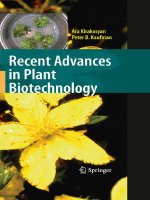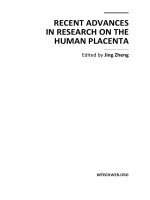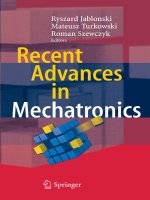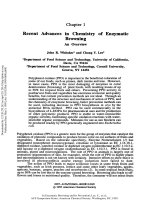Recent advances in laser ablation ICP MS for archaeology
Bạn đang xem bản rút gọn của tài liệu. Xem và tải ngay bản đầy đủ của tài liệu tại đây (11.98 MB, 361 trang )
Natural Science in Archaeology
Laure Dussubieux
Mark Golitko
Bernard Gratuze Editors
Recent Advances
in Laser Ablation
ICP-MS for
Archaeology
Natural Science in Archaeology
Series editors
G€unther A. Wagner
Christopher E. Miller
Holger Schutkowski
More information about this series at />
Laure Dussubieux • Mark Golitko •
Bernard Gratuze
Editors
Recent Advances in
Laser Ablation ICP-MS
for Archaeology
Editors
Laure Dussubieux
Integrative Research Center, Elemental
Analysis Facility
Field Museum of Natural History
Chicago, IL, USA
Mark Golitko
Department of Anthropology
University of Notre Dame
Notre Dame, IN, USA
Bernard Gratuze
Institut de Recherche sur les
Arche´omate´riaux
Centre Ernest Babelon
CNRS/Universite´ d’Orle´ans
Orle´ans, France
ISSN 1613-9712
Natural Science in Archaeology
ISBN 978-3-662-49892-7
ISBN 978-3-662-49894-1
DOI 10.1007/978-3-662-49894-1
(eBook)
Library of Congress Control Number: 2016947426
# Springer-Verlag Berlin Heidelberg 2016
This work is subject to copyright. All rights are reserved by the Publisher, whether the whole or
part of the material is concerned, specifically the rights of translation, reprinting, reuse of
illustrations, recitation, broadcasting, reproduction on microfilms or in any other physical way,
and transmission or information storage and retrieval, electronic adaptation, computer software,
or by similar or dissimilar methodology now known or hereafter developed.
The use of general descriptive names, registered names, trademarks, service marks, etc. in this
publication does not imply, even in the absence of a specific statement, that such names are
exempt from the relevant protective laws and regulations and therefore free for general use.
The publisher, the authors and the editors are safe to assume that the advice and information in
this book are believed to be true and accurate at the date of publication. Neither the publisher nor
the authors or the editors give a warranty, express or implied, with respect to the material
contained herein or for any errors or omissions that may have been made.
Printed on acid-free paper
This Springer imprint is published by Springer Nature
The registered company is Springer-Verlag GmbH Berlin Heidelberg
Prologue
Since its inception as a modern discipline, archaeology has strived to produce
more quantifiable data to test its theories on how human cultures change and
transform. One particularly effective application for charting the transformation of objects of human ingenuity or of human beings themselves has been
through the analysis of the chemical composition of material culture. I refer
to both provenance studies that seek to identify the geological source material of artifacts or ecofacts and to chemical characterization studies focused
on the alteration of a material through biological, environmental, or
manufacturing processes. The former include obsidian sourcing, clay sourcing, metallic ore sourcing, or biological sourcing through isotopic signatures,
for example. The latter include applications such as identifying diagenic
processes on human bone, archaeochemical evidence for metallurgical
activities, or measuring heavy element contaminants in archaeobotanic
materials. Advances in technology in the twentieth century have propelled
the ability of archaeologists to measure and report with much greater precision than ever before on these transformations, creating the discipline of
archaeometry in the process.
Technical advances in instrumentation and techniques have always been a
driver in archaeometry. This is certainly the case with Laser Ablation Inductively Coupled Plasma-Mass Spectrometry (LA-ICP-MS). Since its development toward archaeological applications in the 1990s, LA-ICP-MS has come
into its own as one of the premier archaeological tools for nearly nondestructive multielement compositional analysis of objects (Giussani et al. 2009;
Gratuze et al. 1993: Resano et al. 2010; Speakman and Neff 2005). It builds
on earlier high resolution multielement techniques like Instrumental Neutron
Activation Analysis (INAA), with the same multielement capabilities and
low detection limits in the parts per billion or, in the case of solution, parts
per trillion range. It has high throughput capabilities of tens of samples
processed per day, and unlike INAA, it does not produce dangerous longterm radioactive waste. It is cost-effective and has minimal impact on the
object of study.
LA-ICP-MS is not without its challenges, of course. Technique specific
issues include the stability of the instrument’s detector, accounting for
v
vi
Prologue
doubly charged and oxide species, interferences, and limits of detection (see
Pollard et al. 2007 for detailed descriptions of these problems). Issues with
replicability and reproducibility can create problems for quantitative analysis, especially in heterogeneous materials where difficulty in matrix matching
between the sample and standard may introduce errors. Likewise, the analysis produces large amounts of data that may have varying degrees of accuracy
and precision across elements and matrices. The data must be evaluated for
quality, and unreliable data may be omitted from the analysis. There is a need
for curating large amounts of data long term and making them accessible to
other researchers.
Despite the challenges, LA-ICP-MS has become the most widely utilized
high resolution technique for multielement characterization in twenty-first
century archaeology. Numerous university and museum labs dedicated to
archaeological applications of LA-ICP-MS have sprung into being, and
many other multidisciplinary labs are in existence. There are certain
advantages to having laboratories dedicated to archaeological LA-ICP-MS,
including specialized method development, prioritization of archaeological
sampling, and the development of staff with technological know-how around
archaeological materials. One example of such a lab is The Field Museum’s
Elemental Analysis Facility, founded in 2005. Equipped with a quadrupole
LA-ICP-MS, a standard 213 nm laser, and an experimental adaptable chamber 266 nm laser, the EAF serves archaeologists and collections from around
the world as well as the museum’s own vast archaeological collections
housed in the same building. Several of the chapters in this volume derive
from EAF-based research.
This volume highlights these advances in LA-ICP-MS applications in
archaeology, with reviews of how the technology works (Chap. 1) and
innovations in sample introduction including new adaptable laser cell and
profiling technologies (Chaps. 2–5). The latter chapters are dedicated to
exploring the application of the technique to a variety of material types,
from non-vitreous materials primarily of metallic origin (Chaps. 6–8) to
vitreous materials including glass and obsidian (Chaps. 9–14). The final
chapters explore the expansion of LA-ICP-MS to materials including
slag, garnet, stone, mineralized tissue, and lead glazes (Chaps. 15–19).
This work highlights the results of a 20-year history of Laser Ablation
ICP-MS in archaeology and its potential for future growth. Given the
state of the discipline, it is clear that LA-ICP-MS will continue to revolutionize archaeology as the next generation of archaeologists takes it to new
frontiers.
Integrative Research Center, Social Sciences
Field Museum of Natural History
Chicago, IL, USA
Patrick Ryan Williams
Prologue
vii
References
Giussani B, Monticelli D, Rampazzi L (2009) Role of laser ablation – inductively coupled
plasma – mass spectrometry in cultural heritage research: a review. Anal Chim Acta
635:6–21
Gratuze B, Giovagnoli A, Barrandon J-N, Telouk P, Imbert J-L (1993) Apport de la
me´thode ICP-MS couple´e a` l’ablation laser pour la caracte´risation des
arche´omate´riaux. Revue d’Arche´ome´trie 17:89–104
Pollard M, Batt C, Stern B, Young SMM (2007) Analytical chemistry in archaeology.
Cambridge University Press, Cambridge
Resano M, Garcia-Riuz E, Vanhaecke F (2010) Laser ablation – inductively coupled
plasma mass spectrometry in archaeometric research. Mass Spectrom Rev 29:55–78
Speakman RJ, Neff H (eds) (2005) Laser ablation-ICP-MS in archaeological research.
University of New Mexico Press, Albuquerque, NM
ThiS is a FM Blank Page
Contents
1
Instrumentation, Fundamentals, and Application of Laser
Ablation-Inductively Coupled Plasma-Mass Spectrometry . . . .
Mattias B. Fricker and Detlef G€unther
Part I
Sample Introduction
2
Introduction to Solid Sampling Strategies . . . . . . . . . . . . . . .
Mark Golitko
3
Open-Cell Ablation of Killke and Inka Pottery from
the Cuzco Area: Museum Collections as Repositories
of Provenience Information . . . . . . . . . . . . . . . . . . . . . . . . . .
Mark Golitko, Nicola Sharratt, and Patrick Ryan Williams
4
5
7
8
23
27
Optimization of 2D LA-ICP-MS Mapping of Glass
with Decorative Colored Features: Application to Analysis
of a Polychrome Vessel Fragment from the Iron Age . . . . . .
Johannes T. van Elteren, Serena Panighello, Vid S. Sˇelih,
and Emilio F. Orsega
53
LA-ICP-MS Analysis of Ancient Silver Coins Using
Concentration Profiles . . . . . . . . . . . . . . . . . . . . . . . . . . . . . .
Guillaume Sarah and Bernard Gratuze
73
Part II
6
1
Application to Non-siliceous Materials
Analysis of Non-siliceous Archaeological Materials by
LA-ICP-MS . . . . . . . . . . . . . . . . . . . . . . . . . . . . . . . . . . . . . .
Laure Dussubieux
91
Precise and Accurate Analysis of Gold Alloys: Varna,
the Earliest Gold of Mankind—A Case Study . . . . . . . . . . . .
Verena Leusch, Michael Brauns, and Ernst Pernicka
95
LA-ICP-MS Analysis of Prehistoric Copper and Bronze
Metalwork from Armenia . . . . . . . . . . . . . . . . . . . . . . . . . . . 115
David L. Peterson, John V. Dudgeon, Monica Tromp,
and Arsen Bobokhyan
ix
x
Contents
Part III
Application to Vitreous Materials
9
Analysis of Vitreous Archaeological Materials by
LA-ICP-MS . . . . . . . . . . . . . . . . . . . . . . . . . . . . . . . . . . . . . . 137
Bernard Gratuze
10
Contributions of LA-ICP-MS to Obsidian Sourcing
in the Pacific . . . . . . . . . . . . . . . . . . . . . . . . . . . . . . . . . . . . . 141
Christian Reepmeyer, Wallace Ambrose, and Geoffrey Clark
11
The Role of LA-ICP-MS in the Investigation
of Archaeological Glass . . . . . . . . . . . . . . . . . . . . . . . . . . . . . 163
Simone Cagno, Kevin Hellemans, and Koen Janssens
12
Glass Characterization Using Laser Ablation-Inductively
Coupled Plasma-Mass Spectrometry Methods . . . . . . . . . . . . 179
Bernard Gratuze
13
A Proficiency Test for LA-ICP-MS Laboratories Analyzing
Ancient Glass . . . . . . . . . . . . . . . . . . . . . . . . . . . . . . . . . . . . . 197
Laure Dussubieux
14
Characterization of Slag Inclusions in Iron Objects . . . . . . . . 213
Maxime L’He´ritier, Ste´phanie Leroy, Philippe Dillmann,
and Bernard Gratuze
Part IV
Expanding the Application of LA-ICP-MS
in Archaeology
15
Expanded Applications of Laser Ablation-ICP-MS
in Archaeology . . . . . . . . . . . . . . . . . . . . . . . . . . . . . . . . . . . . 231
Mark Golitko
16
Determining the Provenience of Garnet Beads Using
LA-ICP-MS . . . . . . . . . . . . . . . . . . . . . . . . . . . . . . . . . . . . . . 235
Alison K. Carter
17
Application of LA-ICP-MS to Black Stone Objects
Used During the Iron Age in Celtic Europe . . . . . . . . . . . . . . 267
Anne Baron and Bernard Gratuze
18
Investigating Biogenic Versus Diagenetic Trace
Element Incorporation in Archaeological Mineralized
Tissues with LA-ICP-MS . . . . . . . . . . . . . . . . . . . . . . . . . . . . 323
John V. Dudgeon, Monica Tromp, Bryan K. Hanks,
and Andrei V. Epimakhov
19
Pb Isotopic Composition of Panamanian Colonial Majolica
by LA-ICP-MS . . . . . . . . . . . . . . . . . . . . . . . . . . . . . . . . . . . 343
Javier G. In˜an˜ez, Jeremy J. Bellucci, Juan Guillermo Martı´n,
Richard Ash, William F. McDonough, and Robert J. Speakman
Contributing Authors
Wallace Ambrose Archaeology and Natural History, School of Culture,
History, and Language, Australian National University, Canberra, Australia
Richard Ash Department of Geology, University of Maryland, College
Park, MD, USA
Anne Baron Institut de Recherche sur les Arche´omate´riaux, Centre Ernest
Babelon, CNRS/Universite´ d’Orle´ans, Orle´ans, France
Jeremy J. Bellucci Department of Geology, University of Maryland,
College Park, MD, USA
Department of Geosciences, Swedish Museum of Natural History,
Stockholm, Sweden
Arsen Bobokhyan Institute for Archaeology and Ethnography, Armenian
National Academy of Sciences, Yerevan, Republic of Armenia
Michael Brauns Curt-Engelhorn-Zentrum Archa¨ometrie, Mannheim, Germany
Simone Cagno Department of Chemistry, University of Antwerp, Antwerp,
Belgium
Alison K. Carter Department of Anthropology, University of Illinois at
Champaign-Urbana, Urbana, IL, USA
Geoffrey Clark Archaeology and Natural History, School of Culture,
History, and Language, Australian National University, Canberra, Australia
Philippe Dillmann Laboratoire Arche´omate´riaux et Pre´vision de
l’Alte´ration (LAPA), IRAMAT LMC, UMR 5060 CNRS and NIMBE
UMR 3685 CEA/CNRS, CEA/Saclay, Gif-sur-Yvette Cedex, France
John V. Dudgeon Department of Anthropology, Center for Archaeology,
Materials, and Applied Spectroscopy, Idaho State University, Pocatello, ID, USA
Laure Dussubieux Integrative Research Center, Elemental Analysis
Facility, Field Museum of Natural History, Chicago, IL, USA
Andrei V. Epimakhov Institute of History and Archaeology RAS (South
Ural Department), South Ural State University, Chelyabinsk, Russia
xi
xii
Contributing Authors
Mattias B. Fricker Department of Chemistry and Applied Biosciences,
Laboratory of Inorganic Chemistry, ETH Zurich, Zurich, Switzerland
Mark Golitko Department of Anthropology, University of Notre Dame,
Notre Dame, IN, USA
Bernard Gratuze Institut de Recherche sur les Arche´omate´riaux, Centre
Ernest Babelon, CNRS/Universite´ d’Orle´ans, Orle´ans, France
Detlef G€
unther Department of Chemistry and Applied Biosciences, Laboratory of Inorganic Chemistry, ETH Zurich, Zurich, Switzerland
Bryan K. Hanks Department of Anthropology, University of Pittsburgh,
Pittsburgh, PA, USA
Kevin Hellemans Department of Chemistry, University of Antwerp,
Antwerp, Belgium
Javier G. In˜an˜ez Grupo de Investigacio´n en Patrimonio Construido
(GPAC), Universidad del Paı´s Vasco/Euskal Herriko Unibertsitatea
(UPV/EHU), CIEA Lascaray, Vitoria-Gasteiz, Spain
IKERBASQUE, Basque Foundation for Science, Bilbao, Spain
Koen Janssens Department of Chemistry, University of Antwerp, Antwerp,
Belgium
Maxime L’He´ritier Department of History, Universite´ Paris 8, Saint Denis,
France
Ste´phanie Leroy Laboratoire Arche´omate´riaux et Pre´vision de l’Alte´ration
(LAPA), IRAMAT LMC, UMR 5060 CNRS and NIMBE UMR 3685
CEA/CNRS, CEA/Saclay, Gif-sur-Yvette Cedex, France
Verena Leusch Curt-Engelhorn-Zentrum
Germany
Archa¨ometrie,
Mannheim,
Juan Guillermo Martı´n Universidad del Norte, Barranquilla, Colombia
William F. McDonough Department of Geology, University of Maryland,
College Park, MD, USA
Emilio F. Orsega Department of Molecular Sciences and Nanosystems,
University Ca’Foscari di Venezia, Venice, Italy
Serena Panighello Department of Molecular Sciences and Nanosystems,
University Ca’Foscari di Venezia, Venice, Italy
Ernst Pernicka Curt-Engelhorn-Zentrum
Germany
Archa¨ometrie,
Mannheim,
David L. Peterson Department of Anthropology, Center for Archaeology,
Materials and Applied Spectroscopy, Idaho State University, Pocatello, ID,
USA
Christian Reepmeyer College of Society, Culture and Education, James
Cook University, Cairns, Australia
Contributing Authors
xiii
Guillaume Sarah Institut de Recherche sur les Arche´omate´riaux, Centre
Ernest Babelon, CNRS/Universite´ d’Orle´ans, Orle´ans, France
Vid S. Sˇelih Laboratory for Analytical Chemistry, National Institute of
Chemistry, Ljubljana, Slovenia
Nicola Sharratt Department of Anthropology, Georgia State University,
Atlanta, GA, USA
Robert J. Speakman Center for Applied Isotope Studies, University of
Georgia, Athens, GA, USA
Monica Tromp Department of Anatomy, University of Otago, Dunedin,
New Zealand
Johannes T. van Elteren Laboratory for Analytical Chemistry, National
Institute of Chemistry, Ljubljana, Slovenia
Patrick Ryan Williams Integrative Research Center, Social Sciences, Field
Museum of Natural History, Chicago, IL, USA
ThiS is a FM Blank Page
Abbreviations
ATW
BG
BSED
CA
CCD
CCT
CMG
cps
CRM
DC
DP
DT
EDTA
EF
EPMA
ESA
ESEM
ESR
FI
FTIR
GC
GCMS
GED
GF-AAS
HEAD
HFSE
HIMT
HR-ICP-MS
ICP-MS
ICP-MS-AES
ICP-OES
Atmospheric thin window
Background
Backscattered electron detector
Correspondence analysis
Charge-coupled device
Collision cell technology
Corning Museum of Glass
Counts per second
Certified reference material
Direct current
Depth profile
Dwell time
Ethylenediaminetetraacetic acid
Elemental fractionation
Electron probe microanalysis
Electrostatic sector analyzer
Environmental scanning electron microscope
Electron spin resonance
Fractionation index
Fourier transformed infrared
Gas chromatography
Gas chromatography-mass spectrometry
Gas exchange device
Graphite furnace-atomic absorption spectrometry
High efficiency aerosol dispersion
High field strength element
High iron manganese titanium
High resolution inductively coupled plasmamass spectrometry
Inductively coupled plasma-mass spectrometry
Inductively coupled plasma-atomic emission
spectrometry
Inductively coupled plasma-optical emission
spectrometry
xv
xvi
ICP-Q-MS
ICPS
INAA
IR
ISI
LA
LA-ICP-MS
LAMMA
LIBS
LILE
LIP
LMG
LMHK
LOD
LREE
MC-ICP-MS
MSA
NAA
ND
Nd:YAG
NIST
NORC
NRC
OIB
PCA
PCR
PD
PGE
PIXE-PIGE (or PIGME)
PKT
pLA
PNG
ppb
ppm
PXRF
Py-GC/MS
QA/QC
REE
RF
RGB
RSD
Abbreviations
Inductively coupled plasma-quadrupole-mass
spectrometry
Intensity counts per second
Instrumental neutron activation analysis
Infrared
Internal standard independent
Laser ablation
Laser ablation inductively coupled plasma-mass
spectrometry
Laser microprobe mass analysis
Laser-induced breakdown spectroscopy
Large-ion lithophile element
Late intermediate period
Low magnesium glass
Low magnesium high potassium
Limits of detection
Light rare earth elements
Multi-collector inductively coupled
plasma-mass spectrometry
Magnetic sector analyzer
Neutron activation analysis
Normal distribution
Neodymium-doped yttrium aluminum garnet
National Institute of Standards and Technology
New Ohio Red clay
Non-reduced compounds
Oceanic island basalt
Principal components analysis
Principal component regression
Poisson distribution
Platinum group elements
Particle-induced X-ray
emission—proton-induced gamma-ray emission
Phu Khao Thong
Portable laser ablation
Papua New Guinea
Parts per billion
Parts per million
Portable X-ray fluorescence analysis
Pyrolysis gas chromatography mass
spectrometry
Quality assurance/quality control
Rare earth element
Radio frequency
Red, Green, and Blue
Relative standard deviation
Abbreviations
xvii
SD
SDD-EDS
SEA
SEM-EDS (or EDX)
SG
SI
SIMS
SN
SRM
STD
TEM
TIMS
TOF-MS
TRA
UHP
USGS
UV
VOLM
VUV
WDS or WDX
WNB
XRF
μ-XRF
Standard deviation
Silicon drift detector-energy dispersive
spectrometry
Southeast Asia
Scanning electron microscopy with energy
dispersive X-ray spectrometry
Signal
Slag inclusion
Secondary ion mass spectrometry
Sum normalization
Standard reference material
Standard
Transmission electron microscopy
Thermal ionization mass spectrometry
Time of flight mass spectrometry
Time-resolved analysis
Ultra high purity
United States Geological Survey
Ultraviolet
Volume-optional low memory
Vacuum ultraviolet
Wavelength dispersive X-ray spectroscopy
West New Britain
X-ray fluorescence
Micro-X-ray fluorescence
1
Instrumentation, Fundamentals,
and Application of Laser AblationInductively Coupled Plasma-Mass
Spectrometry
€nther
Mattias B. Fricker and Detlef Gu
Abstract
Laser ablation-inductively coupled plasma-mass spectrometry
(LA-ICP-MS) is becoming a versatile and mature analytical technique
for quantitative major, minor, and trace element analysis and isotope ratio
determinations. A wide variety of solid and liquid samples can be
analyzed. Besides the fast growing application of this method as an
imaging technique, geology still is and has been the major driving force
for the development of LA-ICP-MS. In this review, the method, instrumentation, fundamental observations and quantification procedures are
explained. In addition, pros and cons of the technique are discussed and
some trends and new sampling strategies, with special focus on archaeological applications, are summarized.
1.1
Introduction
Laser Ablation-Inductively Coupled PlasmaMass Spectrometry (LA-ICP-MS) is currently
the technique of choice for trace elemental analysis of solid samples. In the 29 years since the
introduction of LA-ICP-MS in 1985 (Gray
1985), the fundamental principle of the technique
has not changed. In addition to many other
parameters, the performance of LA-ICP-MS
depends upon laser parameters (wavelength,
pulse width), the design of the ablation cell and
M.B. Fricker • D. G€
unther (*)
Department of Chemistry and Applied Biosciences,
Laboratory of Inorganic Chemistry, ETH Zurich,
Vladimir-Prelog-Weg 1, 8093 Zurich, Switzerland
e-mail:
related aerosol transport, and the ICP-MS
operating conditions. The ablation cell is an airtight container, where samples and calibration
reference materials are placed. It incorporates a
window made of a material that is transparent at
the wavelength of the laser being used, through
which the laser beam is focused onto the sample
surface, typically with diameters of tens to
hundreds of μm. Each pulse of the high-energy
laser beam ejects particles of the sample and the
resulting laser generated aerosol is transported to
the ICP by a carrier gas flow (commonly He,
although Ar is also used). During the short residence time (μs-ms) in the plasma at over 6000 K,
the solid aerosol is vaporized, converted to
atoms, and ionized. The ion beam is then
extracted into the mass spectrometer interface,
# Springer-Verlag Berlin Heidelberg 2016
L. Dussubieux et al. (eds.), Recent Advances in Laser Ablation ICP-MS for Archaeology, Natural
Science in Archaeology, DOI 10.1007/978-3-662-49894-1_1
1
2
where the pressure is reduced from ambient to a
moderately high vacuum in two stages, by passing through a sampler cone and a skimmer cone.
In the high-vacuum chamber the ion beam is
shaped by ion optics, and photons as well as
negatively-charged and neutral particles are
separated by a photon stop or similarly functioning ion optics. Positive ions pass through various
kinds of analyzers, where ions with differing
mass to charge (m/z) ratios are separated and
then collected on a detector, where the ions are
either counted or a generated current is
measured.
The purpose of LA sampling is to generate an
aerosol that can be transported, vaporized,
atomized and ionized within the ICP. The ions
thus formed are then extracted into the interface,
separated by the analyzer and recorded by the
detector and associated electronics. For bulk
analysis of homogeneous samples the recorded
transient signal can be integrated for quantification. When performing a line scan along a heterogeneous sample (such as a stalagmite, paint
layers, or bronze objects, for instance), the transient signal can be used to show variations which
correspond to concentration changes in the sample and provide insights into growth or the
manufacturing procedure. Parallel line scans
can be performed across an area of the sample
yielding the distribution of elements in two
dimensions, i.e. elemental imaging or mapping,
which is today one of the fastest growing
applications of LA-ICP-MS. Recording these
variations in transient signals requires an ablation
cell with a fast washout of the aerosol to minimize mixing of aerosol from different positions
of the sample, allowing higher spatial resolution.
Most commercially available ablation cells are
relatively small, requiring cutting large samples
into smaller pieces in order for the sample piece
to fit into the ablation cell. For many samples,
cutting and resulting destruction is not possible,
thus a large ablation cell able to contain larger
samples in their entirety, is required. Analysis
without any ablation cell would be most ideal
for many applications, and some promising
approaches are discussed later in this chapter.
M.B. Fricker and D. G€
unther
Research and development of LA-ICP-MS
during the last decade has produced a large number of applications, which is largely due to the
fact that using this technique, samples are
analyzed under atmospheric pressure, which
makes LA-ICP-MS easier to apply when compared to secondary ion mass spectrometry
(SIMS), laser microprobe mass analysis
(LAMMA), or electron probe micro-analysis
(EPMA). All of these techniques require
low-pressure vacuum conditions, which limits
their applicability to some samples. However, it
must be mentioned that some of the figures of
merit for these techniques (limits of detection,
spatial resolution) are superior compared to LAICP-MS. Furthermore, EPMA is often a complementary technique to LA-ICP-MS, as it allows
the determination of major elements very accurately, a prerequisite of trace element
determinations (e.g. Dussubieux et al. 2008).
The ability to obtain quantitative determinations
of major and trace element composition in any
solid sample along with the ability to determine
isotope ratios with high accuracy and high precision are some of the key reasons for the success
of LA-ICP-MS. The technique is widely used in
many areas, but especially in earth sciences,
gemology, material sciences, and industrial quality control applications (Durrant 1999). Apart
from bulk- and microanalysis of archeological
objects, e.g. glass and ceramics (Barca
et al. 2007; Dussubieux et al. 2007; Gratuze
1999), and depth profiling (Pisonero et al. 2007;
Plotnikov et al. 2001), more advanced
applications such as analyses or fingerprinting
of gemstones and archeological objects such as
pottery and ceramics (Arnold et al. 2012;
Fontaine et al. 2010; Vaughn and Dussubieux
2011), isotope ratio determinations (Cottle
et al. 2009) and elemental imaging and/or line
scans (Bi et al. 2000; Campbell and Humayun
1999; Raab et al. 2009; Sinclair et al. 1998; Treble et al. 2003; Wirth et al. 2009), profiling
(Mattey et al. 2008), and mapping (Becker
et al. 2005; Treble et al. 2005; Woodhead
et al. 2007) are rapidly growing applications,
and provide valuable information for different
fields of research.
1
Instrumentation, Fundamentals, and Application of Laser. . .
1.2
Instrumentation
1.2.1
Inductively Coupled
Plasma-Mass Spectrometry
The most common sample introduction systems
used with ICP as an ion source are schematically
shown in Fig. 1.1. The two basic systems are used
for liquid samples or for solid samples or
combinations thereof. The six most common
mass analyzers used for ICP are also shown
schematically, and will be explained in more detail
in the following sections. Soon after ICP-MS was
introduced, reports of elemental analysis were
published with solution nebulization remaining
the dominant sample introduction device (Jenner
et al. 1990). The first coupling to laser ablation
(Gray 1985), and later overviews (Durrant 1999;
Hattendorf et al. 2003; Jackson et al. 1992; Russo
et al. 2002a) gave some indications of the versatility of this ionization source. ICP-MS has several
advantages in comparison to the longer established
method of ICP-Optical Emission Spectrometry
(ICP-OES), including lower limits of detection, a
wider linear dynamic range, access to isotopic
information, and simpler spectra. Due to the sensitivity of this technique, analyte concentrations
can be diluted in solution ICP-MS (Longerich
2012), which reduces matrix effects and
contributes to the wide range of applications
reported in the literature.
The ion source, an argon plasma, vaporizes
introduced particles, converts molecules to
atoms, and ionizes these atoms, regardless of
whether sample enters as a gas, liquid, or solid.
The ion beam is then extracted through an interface where the sample passes through a sampler
cone and a skimmer cone in two or three stages,
dropping from atmospheric pressure into a moderate vacuum. A photon stop or equivalent
device, removes negatively charged ions,
neutrals and photons from the ion beam, which
is then shaped by the ion optics before entering
the mass analyzer. The mass filter (or analyzer)
separates these ions by their mass to charge
ratios, which are then counted by a single detector or multi collector.
3
The three most common types of mass
analyzers in inorganic mass spectrometry are
the quadrupole, the magnetic sector, and the
time of flight mass spectrometer (TOF-MS), as
shown in Fig. 1.1. The quadrupole is a low resolution, fast sequential mass filter consisting of
four parallel rods, connected pair-wise to radio
frequency (RF) voltage and direct current
(DC) voltage. Depending on the applied
voltages, ions of only one mass to charge ratio
pass through the filter and are focused onto the
detector. All types of ICP-MS suffer from
interferences, as the mass analysers separate
ions based on their mass to charge ratios, most
often singly charged ions of an isotope of an
element. Several isobaric interferences occur
due to overlapping ions or the formation of polyatomic ions with a similar mass per charge ratio
(Hattendorf and G€unther 2001; Houk et al.
1980). A selection of some more common interference types are listed in Table 1.1, which occur
at low mass resolution (m/Δm¼300, quadrupole
ICP-MS). These interferences also occur during
LA, however, oxide formation is significantly
lower with dry aerosol introduction.
If alternative isotopes that do not suffer from
interference are not available, high resolution
(HR) ICP-MS can overcome most interferences.
The most widely used HR-ICP-MS instrumentation is based on various combinations of a magnetic field analyzer (MSA), and an electrostatic
analyzer (ESA, a kinetic energy analyzer) with
single, multiple or array detectors as shown in
Fig. 1.1. The sector field ICP-MS with a single
detector usually uses a magnetic field prior to the
ESA, which is known as reverse Nier-Johnson
geometry. Sector field ICP-MS with several
detectors (multi collector or MC) ICP-MS
(Nier-Johnson geometry) has also been used for
more precise isotope ratio measurements. This
instrument type records isotope signals simultaneously with high precision, and has found application in geochronology and other analyses
requiring precise measurement of isotope ratios
(Halliday et al. 1998). Developments have been
made towards simultaneous detection of all
elements (from m/z 7 to 250) using a Mattauch-
4
M.B. Fricker and D. G€
unther
Fig. 1.1 Schematic representation (Fricker 2012) of the
most common optical emission and mass spectrometer
configurations used in combination with ICP as the photon emission or ion source: torch, load coil, plasma, and
interface (C). Aerosols generated from solution nebulization (A) or from laser ablation (B) are transported (dotted
line) to the ion source (C). The ions (grey solid line) can
be separated using several types of analyzers (E–I) before
being converted to a suitable electrical signal by various
detectors. The quadrupole (E) and the single collector
(reverse Nier-Johnson) sector field (F) are sequential
MS, while G (multi collector, Nier-Johnson geometry)
and H (Mattauch-Herzog geometry) are simultaneous
MS. The time-of-flight (I) is a pulsed MS and while not
exhibiting simultaneous detection does simultaneously
sample the ions. ICP optical emission spectrometry is
represented by D which shows a multichannel system
Table 1.1 List of selected common interferences and
backgrounds in ICP-MS analysis (Fricker 2012) and
suggested alternative isotopes
with an array detector (Cromwell and
Arrowsmith 1996; Felton et al. 2011; Fricker
2012; Resano et al. 2012; Schilling et al. 2009).
The coupling of TOF-MS to the ICP ion source is
complicated due to the continuous ion beam
delivered to the ICP and the pulsed nature of
the TOF analyzer. However, reports using ICPTOF-MS have been published (Borovinskaya
et al. 2013; Feldmann et al. 2002; Gonzalez
et al. 2012; Guilhaus 2000; Mahoney
et al. 1996; Myers and Hieftje 1993; Tanner and
G€unther 2006) and commercially available and
custom built instruments are currently both in
use. The TOF-MS configuration is potentially
very interesting for the simultaneous sampling
of all isotopes and therefore very interesting for
direct solid analysis by laser ablation. However,
early TOF-MS instruments had significantly
lower sensitivity when compared to available
Interference
form
An++
AnAr+
AnO+
O2+
An+
AnCl+
Interference
example
138
Ba+
23
Na40Ar+
40
Ar16O+
16
O2+
50 +
Cr
40
Ar35Cl+
Ar+, high
abundance
40
Ar+, 80Ar+
Isotope of
interest
69
Ga+
63
Cu+
56 +
Fe
32 +
S
50 +
Ti
75
As+
40
Ca+,
Se+
80
Alternative
71
Ga+
65
Cu+
57
Fe+
34 +
S
48 +
Ti
HR-ICPMS
42
Ca+,
78
Se+
The formation of interferences needs to be evaluated for
each analysis, as interferences heavily depend on matrix
composition. Analyte (An) can be any element to be
detected
Herzog ESA-MSA sector field geometry
(Mattauch and Herzog 1934) in combination
1
Instrumentation, Fundamentals, and Application of Laser. . .
quadrupole or sector field instruments. Recent
developments in TOF-MS have achieved limits
of detection comparable with quadrupole
ICP-MS (Borovinskaya et al. 2013).
1.2.2
Laser Ablation
The availability of ruby lasers first led to studies
which introduced solid aerosols instead of liquid
droplets into an ICP ion source. The early development of laser ablation was carried out by coupling LA to an ICP-Optical Emission
Spectrometer (Carr and Horlick 1982; Ishizuka
and Uwamino 1983; Thompson et al. 1981),
which was soon followed by LA-ICP-MS
(Arrowsmith 1987; Arrowsmith and Hughes
1988; Gray 1985). The laser is commonly used
as a micro-sampling device, with the laser beam
focused onto the sample surface using spot sizes
of between ~ten to a hundred or more μm
diameters. The high-energy laser pulse ablates a
small amount of sample, which is transported by
a carrier gas as a solid aerosol or gas phase via
transport tube into the ICP. In contrast to all other
laser-based techniques, in LA-ICP-MS, sampling
and aerosol ionization are physically separated
from each other. This is one of the major
advantages of this technique as 100 % aerosol
transport and 100 % vaporization within the ICP
allows quantitative analysis without using matrix
matched calibration materials.
The types of lasers used for LA-ICP-MS are
categorized (Table 1.2) by lasing source, the
wavelength
of
the
emitted
energy
(157–1064 nm), and the pulse duration (approximately nanosecond to femtosecond range). All
lasers used for ablation are pulsed lasers. The
most common types are solid state lasers (Nd:
YAG) and gas lasers (ArF excimer) both of
which have ns pulse widths. More recently
IR/UV fs Ti:sapphire solid state lasers have also
been applied for various applications.
Most solid state lasers, such as the Nd:YAG,
emit light in the near infrared (1064 nm) which can
be frequency doubled (532 nm), tripled, quadrupled (266 nm), or quintupled (213 nm). However,
each step of frequency multiplication results in the
5
Table 1.2 Wavelength of the first harmonic (bold type)
of various available lasers, and frequency multiplied
wavelengths
Ti:
sapphire,
~30–150 fs
Nd:YAG,
<6 ns
ArF,
15–20 ns
IR
760–820 nm
VIS
1064 nm
532 nm
(2nd)
UV
380–410 nm
(2nd), 265 nm
(3rd)
355 nm (3rd),
266 nm (4th),
213 nm (5th)
193 nm
loss of energy. Despite the lower energy output,
short wavelength lasers are now most often used,
as it has been shown that shorter wavelength LA
generates aerosols with nm particle sizes favorable
for ICP-MS due to more complete vaporization
within the plasma (Guillong and G€unther 2002).
Several reports of the superior qualities of UV LA
compared to IR LA have been published (Geertsen
et al. 1994; Jeffries et al. 1995, 1998; Shuttleworth
1996). The output energy of an ArF excimer laser
is sufficiently high (240 mJ) to enable the use of
beam homogenizing optics, leading to flat top laser
beam profiles that result in more controlled, homogeneous ablation, and flat bottomed ablation
craters. Despite the loss of energy through the
additional optical components used, fluencies of
more than 40 J/cm2 can be reached. The use of
a homogenized beam improved precision and
accuracy in various applications, particularly on
highly transparent samples (G€unther et al. 1997;
Heinrich et al. 2003). Another advantage of the
imaging optics is that the beam energy density
is independent of the crater size. The schematic
optical beam path of a 193 nm ArF laser ablation
system is shown in Fig. 1.2. Performing flat
top ablation leads to improved signal stability
over time, whereas a Gaussian profile crater
quickly reaches a critical depth from which little
or no aerosol leaves the crater site. The influence
of the aspect ratio (depth/diameter) and its significant influence on the representative aerosol sampling has been studied in detail by Mank and
Mason (1999).
The influence of carrier gas composition on
laser-generated aerosol transport has also been
M.B. Fricker and D. G€
unther
CCD camera
6
Lens
Power meter
(alternatively)
Petrographic
microscope
N2 in
Excimer laser
(ArF, 193 nm)
Adjustment
diode
laser
Optical beam path
Mirror
Beam splitter
Schwarzschild
objective
Ar
in
Ar
Out
Ablation cell
with sample
Prism set up
Homo-genizer
arrays
Field
lens
Mask
aperture
Raw
laser
beam
Condenser
lens
Schwarzschild
objective
Microscope
Observation through
dielectric 193 nm
mirror
Primary mirror
Secondary
mirror
Chamber
window
Image
Fig. 1.2 The ArF excimer laser and details of the beam homogenizer (G€
unther et al. 1997). Reproduced with
permission of the Royal Society of Chemistry
studied (Eggins et al. 1998; G€unther and
Heinrich 1999; Mank and Mason 1999). Eggins
et al. (1998) proposed the use of He which allows
a more efficient transport of smaller aerosol
particles resulting in a three- to fivefold increase
in sensitivity and a significant reduction in surface deposition of ablated material around ablation craters. Sensitivity enhancement has also
been observed by the addition of small amounts
of H2 to the carrier gas, upstream of the ablation
cell (Guillong and Heinrich 2007), which is
especially useful for elements with high ionization potentials.
The
quantitative
analysis
of
trace
concentrations of rare earth elements in a variety
of minerals were reported by Jackson
et al. (1992), using a 1064 nm Nd:YAG laser.
Soon after this study, limitations to the accurate
quantitative determination of some analytes were
discovered when analyzing a wide variety of
elements, including highly volatile ones. This
phenomenon was dubbed elemental fractionation
1
Instrumentation, Fundamentals, and Application of Laser. . .
(Fryer et al. 1995), and later shown to originate
not only from non-stoichiometric sampling, but
also processes taking place during aerosol transport (Koch et al. 2004), and incomplete vaporization in the plasma (Guillong and G€unther
2002). Different types of fractionation are mainly
caused by the ablation process, and it has been
shown that a reduction in laser wavelength
towards vacuum ultraviolet (VUV) improves
the absorption of laser energy, leading to an
aerosol size which can be better transported and
vaporized within the ICP. For non-conducting
samples, the use of an 193 nm wavelength ArF
Excimer laser was shown to reduce elemental
fractionation due to improved absorption of the
laser by the sample.
This resulted in a more controlled ablation,
where controlled means that the rate of ablation
was slower and the resulting craters showed
reduced amounts of surrounding debris. More
homogeneous energy distribution also produced
fewer molten particles and flat bottomed craters.
Improved ablation behavior was demonstrated
on quartz samples when analyzing fluid
inclusions in mineral thin sections (G€unther
et al. 1997, 1998) and many other applications
(see Heinrich et al. 2003). Furthermore, the use
of He as carrier gas for transporting lasergenerated aerosols, first reported by Eggins
et al. (1998), led to improved transportation of
nm-sized particles and thus to more complete
vaporization in the plasma. Other laser systems
in the UV range (213 nm and 266 nm,
e.g. Jeffries et al. 1998) also became available.
The fundamental differences in particle size distribution produced by the three (266, 213, and
193 nm) UV laser wavelengths are reported by
Guillong et al. (2003), who showed the
advantages of the VUV wavelengths, particularly
improved particle size distribution. The importance of particle size distribution has led to studies investigating ICP-induced fractionation on
generated aerosol using various laser
wavelengths (Guillong and G€unther 2002). It
has been shown that incomplete vaporization of
large particles in the plasma can take place. For
example, Guillong et al. (2003) and Kuhn and
G€unther (2003) demonstrated that larger particle
7
sizes (sizes >150 nm) are not completely
vaporized within the ICP. This effect was
visualized by Aeschliman et al. (2003), who
observed incompletely vaporized particles passing through the plasma. As a result of these issues
with fractionation, today most of the laser
systems applied for non-conducting samples in
geology, medicine, and archaeology are excimer
lasers (193 nm) or solid state Nd:YAG lasers
operated at 213 nm.
Further developments in laser technology
have led to the introduction of femtosecond
(fs) lasers as a sampling tool. Studies utilizing
fs lasers for LA of metallic samples were first
published using Laser-Induced Breakdown Spectroscopy (LIBS) (Margetic et al. 2000). The first
application using LA-ICP-MS was Fe isotope
ratio determinations performed using a
196 nm fs LA system coupled to a MultiCollector (MC)-ICP-MS instrument (Horn
et al. 2006). The advantages of using fs lasers,
in particular when ablating conducting samples,
has been demonstrated by analyzing the stoichiometric composition of the aerosols formed during
ablation (Garcia et al. 2008, see also a review by
Koch and G€
unther 2011). It has been shown that
the elemental composition of the various
particles sizes is not equal, which was already
known from nanosecond (ns) LA experiments.
However, the overall composition of all particle
sizes, when combined, represented the stoichiometry of the ablated sample. Given the stoichiometry and knowing that the transport efficiency
is comparably high (determined between 78 and
92 %) (Garcia et al. 2008; Wa¨lle et al. 2009) and
the fact that fs-LA produces particles small
enough to be completely vaporized, it becomes
clear that fs-LA is advantageous. Studies on the
differences between ns and fs lasers, the expansion of the laser plume and aerosol formation
(Koch et al. 2007, 2008a, 2010), transport and
transport efficiency of laser-generated aerosols
(Garcia et al. 2007, 2008), visualization of the
expansion of laser aerosols within the ablation
cell (Koch et al. 2008b) and within the transport
tubes (Koch et al. 2008a) have been extensively
reported. All studies revealed that the expansion
of the aerosols is significantly different between









